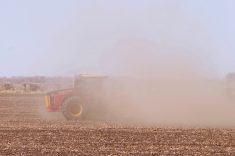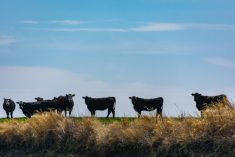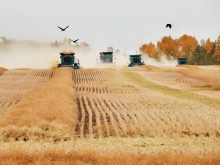Jack and Martha, as we’ll call them, farm 1,760 acres in central Manitoba. At the ages of 67 and 62, they are thinking of handing over the reins of their operation to their son, Bob, who is 30 and already active in running the farm.
Bob will be the fourth generation of his family to farm. The farm started at 160 acres in 1911, the next generation added 320 acres, then Jack added another 320 acres and Bob bought another 320 acres of his own. An uncle died leaving Bob a further 640 acres. Bob effectively runs the total of 1,760 acres.
Read Also

Gentle treatments for pain in the neck
Heading toward year-end, people unknowingly tense up against the cold and busyness, causing neck pain that can often be treated with appropriate support and gentle mobility, athletic therapist Kathlyn Hossack says.
The family has a tradition of setting up each younger generation to farm the legacy. The effect is to allow the older generation to watch the younger, to pass on skills and wisdom, and to avoid many of the problems of succession. The plan is as simple as the tradition.
Farm Financial Planner asked Don Forbes and Erik Forbes, farm financial planners with Don Forbes & Associates/Armstrong & Quaile Associates Inc. in Carberry, Manitoba, to work with Jack and Martha
The situation
The entire holding, which is a mix of pasture, hay and feed corn, has a total value of about $500,000, assuming that it could be sold for about $285 per acre. As well, the couple receives a portion of beef cattle sales from their herd of 80 beef cows which give them $1,000 per month as farm income.
When they leave farming to Bob, their income will be based on cattle sales, as indicated, plus two Old Age Security benefits of $6,612 per year each, total, $13,224, plus annual Canada Pension Plan benefits of $12,144 combined. The total, including $12,000 year cattle income, $37,368 before tax will leave them with $2,800 per month after 10 per cent average income tax. If they continue to spend just $2,000 per month, their budget will be in the black and amply covered, Erik Forbes estimates.
Jack and Martha can supplement their farm and government benefits by drawing on their financial assets which include non-registered accounts worth $20,110, RRSPs worth $4,240 and miscellaneous assets worth $7,236. Jack, turning 65 this year, can begin withdrawing $2,000 per year from his Registered Retirement Income Fund and will receive offsetting tax credits. That will make the year withdrawal tax-free. Any capital gains or interest income on non-registered accounts will be realized, leaving a small amount of tax to be paid.
If the total, $31,635, grows at three per cent per year after inflation to $36,616 in five years, then when Jack is 72, he must take income from his Registered Retirement Income Fund at about eight per cent per year. He and Martha will be able to add RRIF income of $2,929 for total pre-tax income of about $40,300. Their disposable income after 10 per cent average tax would be $3,022 per month. Their surplus based on current spending of $2,000 per month will leave them with monthly savings of about $1,000 per month, Don Forbes says.
The couple plans to continue their modest way of life without costly travel. Much of their food comes from the farm. Jack bags a few deer each year and the farm business picks up a few of their other expenses. Their home does not need costly repairs. Even on their modest income of $2,000 per month, they expect to put away $500 per month for the next 10 years for Registered Educational Savings Plans for their five grandchildren. Over 10 years, by which time their eldest grandchild will be ready for university, with the addition of the lesser of 20 per cent of contributions or $500 per child from the Canada Education Savings Grant, that will add up to $85,000, assuming they obtain a three per cent return after inflation. The money, which can continue to grow with contributions and gains, can pay for a year or two of post-secondary education for each grandchild provided that the child lives at home or obtains very economical room and board near the institution of his or her choice, Erik Forbes estimates.
Other options
There is a good deal more that the couple can do to increase their income and financial security in retirement. First move would be to crystallize the value of their farming business and arrange a sale to Bob. The farm must eventually be disposed of through deemed disposition no later than the death of the last parent. If Bob were to pay Jack and Martha at, say, $25,000 per year or, though borrowing is not the family tradition, the entire $500,000, which they could offset with the $800,000 lifetime capital gains exemption, then the income would raise the parents’ income by $22,500 per year after 10 per cent average income tax, Don Forbes says.
Gifting the farm to Bob for a dollar, which is the plan, will require Bob to provide for his parents’ future well being. He will have to cover much the parents’ living costs, but on the other hand, if the farm were sold for fair market value, Bob’s standard of living would fall. The farm is 30 miles from the nearest town and 60 from a hospital. Clearly, the cost of access will be high and will be Bob’s to pay. The bill for going to town, to doctors or hospitals, could be $1,000 per month or $12,000 per year, Forbes suggests. Over the lifetime of the parents, who have longevity in their own family histories, the bill could be quite substantial, Don Forbes notes.
Getting more money for the farm would, of course, aid the parents. They could buy long term care insurance, for example. Moreover, the farm is a single asset and much of their retirement income will dependent on its health. If they could obtain $500,000, they might invest in a range of stocks, particularly those that have paid dividends consistently and raised them each year for the last five years. Several dividend income exchange traded funds are available with modest annual management fees well below one per cent of net asset value. Diversification is a form of insurance, Erik Forbes observes. Yet all that won’t happen, for the plan is for them to live simply in town supported by Bob who will have the farm for a dollar.
For his part, Bob, who will run the farm, should examine ways to generate additional income. The land, presently used mostly for pasture for relatively few animals, could support limited grain production on perhaps a third of the acreage. More hay could be produced as well. Bob, like each generation before him, has spent a good deal of time as a tradesman. Today, he is a skilled machinist. That work subsidizes the farm. It is the way the family has run the business for three generations. Tradition, not maximizing returns, is the family’s guiding principle.
Andrew Allentuck’s latest book, ‘When Can I Retire? Planning Your Financial Life After Work,’ was published by Penguin Canada in 2011.














